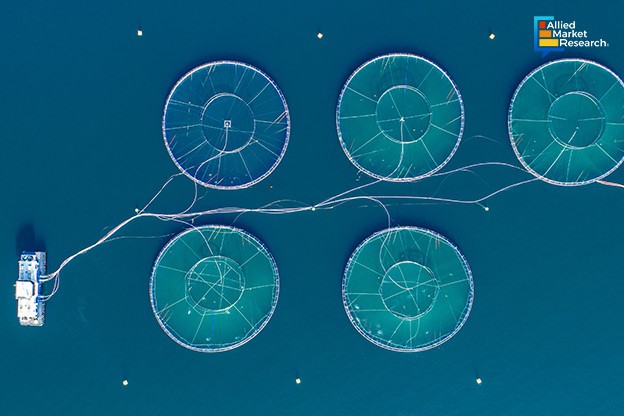Technological Advances in Aquaculture Revolutionizing Seafood Production

11 Mar
2025
Highlights:
- A brief on aquaculture
- Prominent forms of seafood production
- Notable advancements in aquaculture methods
- Key acquisitions by top players in the sector
Aquaculture encompasses the cultivation of aquatic organisms in controlled water environments for commercial, recreational, or public use. This process involves breeding, rearing, and harvesting both plants and animals in various settings, including ponds, rivers, lakes, oceans, and land-based closed systems.
Apart from food production for human consumption, aquaculture serves a wide range of purposes. It helps restore populations of endangered species and supports biodiversity conservation. Additionally, aquaculture aids in habitat restoration, helping to repair damaged ecosystems. Furthermore, it also produces baitfish, which are crucial for both recreational and commercial fishing. In addition, it provides fish for zoos and aquariums, supporting educational and conservation efforts in these institutions.
Major forms of aquaculture supporting several businesses
In the last few years, the aquaculture industry has experienced significant growth as it has become one of the fastest growing seafood production forms in the world. With global wild fisheries facing challenges in wide-scale harvesting, aquaculture is increasingly recognized as a sustainable solution to meet the rising seafood demand. Researchers and the aquaculture industry use advanced methods to grow various freshwater and marine species like fish and shellfish.
Marine aquaculture involves the cultivation of species that live in saltwater environments such as oceans and estuaries. Commonly farmed species include salmon, oysters, mussels, shrimp, and seaweed. Marine aquaculture is typically conducted in net pens in open water or tanks on land. In the U.S., marine aquaculture accounts for just 20% of total production, primarily dominated by shellfish cultivation.
On the other hand, freshwater aquaculture focuses on species that thrive in freshwater environments like ponds and rivers. Popular examples include catfish, trout, tilapia, and carp. Freshwater aquaculture often occurs in man-made systems such as ponds or raceways. It represents about 70% of U.S. aquaculture production, with catfish and trout being the most farmed species.
Innovations in aquaculture methods reshaping the industry’s growth
The industry has undergone a technological revolution to meet global seafood demand sustainably. These innovations focus on improving efficiency, reducing environmental impacts, and enhancing fish welfare. Recirculating aquaculture systems have emerged as a land-based technology that allows fish farming in controlled environments with minimal water usage. These systems recycle water through filtration processes, achieving up to 100% water reuse. In addition, the integration of AI and IoT have led to advanced monitoring systems that optimize water quality, feeding schedules, and fish health.
Furthermore, integrated multi-trophic aquaculture is one of the advanced methods that mimics natural ecosystems by farming multiple species together. Fed species like salmon or shrimp are cultivated alongside filter feeders and seaweed. Waste from fed species serves as nutrients for other species, improving water quality and reducing environmental impact. This approach diversifies income streams for farmers while promoting ecological balance.
Aqua Bridge Group and AVRAMAR joined hands to boost Mediterranean aquaculture
In January 2025, Aqua Bridge Group, a Dubai-based aquaculture company announced its acquisition of AVRAMAR’s Greek fish farming assets, showcasing a notable move in the Mediterranean aquaculture sector. This acquisition is expected to bring stability and innovation to one of the region’s largest producers amid ongoing challenges. AVRAMAR operates in both Greece and Spain, with a strong presence in both markets. In Greece, the company employs around 2,300 people across multiple facilities, including hatcheries, feed manufacturing plants, farms, processing and packaging units, and logistics centers. The Greek operations contribute significantly to AVRAMAR’s total production, with an annual capacity exceeding 170,000 tonnes.
WorldFish and Kytos partnered to advance aquaculture microbiome management
In August 2024, WorldFish, an international organization working to transform aquatic food systems signed an agreement with Kytos, a leading microbial management technology provider operating in Belgium, Vietnam, and Thailand. This partnership aims to advance research and development in aquaculture microbiome management, enhancing aquatic animal health, productivity, and food security across key regions, including Southeast Asia, India, Bangladesh, the South Pacific, and Africa. Dr. Rodrigue Yossa, WorldFish Director of Aquatic Food Bioscience, said that this collaboration represents a major advancement in its efforts to revolutionize aquatic food systems. He added that the company aims to drive sustainable growth and strengthen the economic resilience of aquaculture industries globally by implementing Kytos’ cutting-edge microbial management technologies.
Summing up
Continuous developments in aquaculture methods are expected to address the growing demands for seafood while reducing pressure on wild fish stocks. By adopting sustainable practices, the sector is likely to provide economic benefits, enhance food security, and contribute to environmental conservation.
Reach out to our industry specialists to gain more insights into the latest trends in the aquaculture industry!

Koyel Ghosh
Author’s Bio- Koyel Ghosh is a blogger with a strong passion and enjoys writing in miscellaneous domains, as she believes it lets her explore a wide variety of niches. She has an innate interest in creativity and enjoys experimenting with different writing styles. A writer who never stops imagining, she has been serving the corporate industry for the last five years.
Avenue: Entire Library membership of Allied Market Research Reports at your disposal
- Avenue is an innovative subscription-based online report database.
- Avail an online access to the entire library of syndicated reports on more than 2,000 niche industries and company profiles on more than 12,000 firms across 11 domains.
- A cost-effective model tailored for entrepreneurs, investors, and students & researchers at universities.
- Request customizations, suggest new reports, and avail analyst support as per your requirements.
- Get an access to the library of reports at any time from any device and anywhere.
Related Post
-
How are Submarine Cables Transforming Global Connectivity with Enhanced User Experience?
-
Endoscopy Procedures: Transformations in Techniques and Applications
-
AI-Powered Video Analytics: How the Product Actually Works for enterprises
-
Painting Robots: Transforming Precision Coating and Creative Applications
-
Innovations in Pharmacovigilance Systems Advancing Patient Safety
-
Understanding Edge Security: Keeping Data Safe Near the Source
-
Exploring the Use and Advancements of 3D Laser Scanners in Professional Applications
-
Reinforcing Industrial Controls with Smarter Tools and Training








